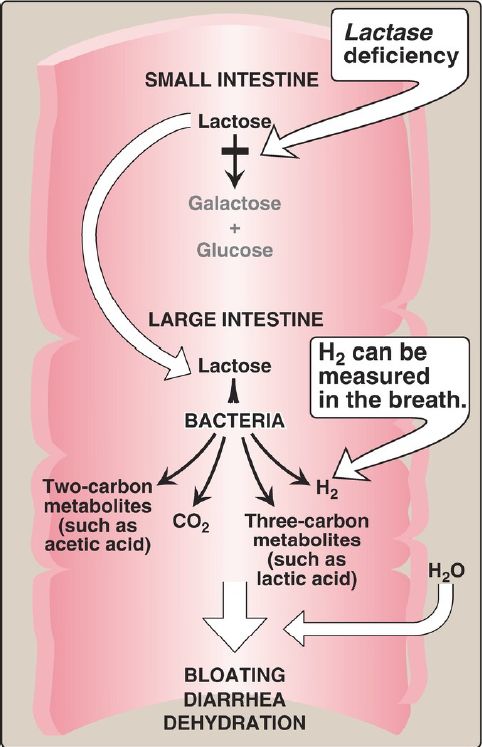


 النبات
النبات
 الحيوان
الحيوان
 الأحياء المجهرية
الأحياء المجهرية
 علم الأمراض
علم الأمراض
 التقانة الإحيائية
التقانة الإحيائية
 التقنية الحيوية المكروبية
التقنية الحيوية المكروبية
 التقنية الحياتية النانوية
التقنية الحياتية النانوية
 علم الأجنة
علم الأجنة
 الأحياء الجزيئي
الأحياء الجزيئي
 علم وظائف الأعضاء
علم وظائف الأعضاء
 الغدد
الغدد
 المضادات الحيوية
المضادات الحيوية|
Read More
Date: 7-1-2022
Date: 11-9-2021
Date: 30-10-2021
|
Abnormal Degradation of Disaccharides
The overall process of carbohydrate digestion and absorption is so efficient in healthy individuals that ordinarily all digestible dietary carbohydrate is absorbed by the time the ingested material reaches the lower jejunum.
However, because only monosaccharides are absorbed, any deficiency (genetic or acquired) in a specific disaccharidase activity of the intestinal mucosa causes the passage of undigested carbohydrate into the large intestine. As a consequence of the presence of this osmotically active material, water is drawn from the mucosa into the large intestine, causing osmotic diarrhea. This is reinforced by the bacterial fermentation of the remaining carbohydrate to two- and three-carbon compounds (which are also osmotically active) plus large volumes of carbon dioxide and hydrogen
gas (H2), causing abdominal cramps, diarrhea, and flatulence.
1. Digestive enzyme deficiencies: Genetic deficiencies of the individual disaccharidases result in disaccharide intolerance. Alterations in disaccharide degradation can also be caused by a variety of intestinal diseases, malnutrition, and drugs that injure the mucosa of the small intestine. For example, brush border enzymes are rapidly lost in normal individuals with severe diarrhea, causing a temporary, acquired enzyme deficiency. Therefore, patients suffering or recovering from such a disorder cannot drink or eat significant amounts of dairy products or sucrose without exacerbating the diarrhea.
2. Lactose intolerance: Over 60% of the world’s adults are lactose intolerant (Fig. 1). This is particularly manifested in certain populations. For example, up to 90% of adults of African or Asian descent are lactase deficient. Consequently, they are less able to metabolize lactose than are individuals of Northern European origin. The age-dependent loss of lactase activity starting at approximately age 2 years represents a reduction in the amount of enzyme produced. It is thought to be caused by small variations in the DNA sequence of a region on chromosome 2 that controls expression of the gene for lactase, also on chromosome 2.
Treatment for this disorder is to reduce consumption of milk; eat yogurts and some cheeses (bacterial action and aging process decrease lactose content) as well as green vegetables, such as broccoli, to ensure adequate calcium intake; use lactase-treated products; or take lactase in pill form prior to eating. [Note: Because the loss of lactase is the norm for most of the world’s adults, use of the terms adult-type hypolactasia or lactase nonpersistence rather than lactose intolerance is becoming more common.] Rare cases of congenital lactase deficiency are known.

Figure 1: Abnormal lactose metabolism. CO2 = carbon dioxide; H2 =hydrogen gas.
3. Congenital sucrase-isomaltase deficiency: This autosomal-recessive disorder results in an intolerance of ingested sucrose. Congenital SI deficiency has a prevalence of 1:5,000 in individuals of European descent and appears to be much more common (up to 1:20) in the Inuit people of Greenland and Canada. Treatment includes the dietary
restriction of sucrose and enzyme replacement therapy.
4. Diagnosis: Identification of a specific enzyme deficiency can be obtained by performing oral tolerance tests with the individual disaccharides. Measurement of H2 in the breath is a reliable test for determining the amount of ingested carbohydrate not absorbed by the body, but which is metabolized instead by the intestinal flora (see Fig. 1).



|
|
|
|
دراسة يابانية لتقليل مخاطر أمراض المواليد منخفضي الوزن
|
|
|
|
|
|
|
اكتشاف أكبر مرجان في العالم قبالة سواحل جزر سليمان
|
|
|
|
|
|
|
اتحاد كليات الطب الملكية البريطانية يشيد بالمستوى العلمي لطلبة جامعة العميد وبيئتها التعليمية
|
|
|